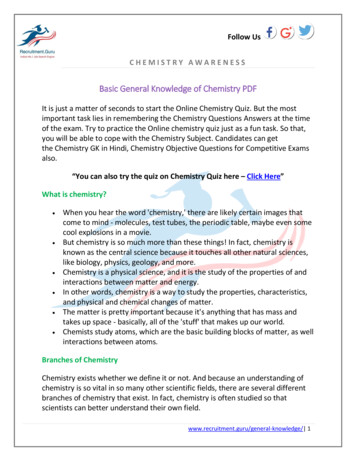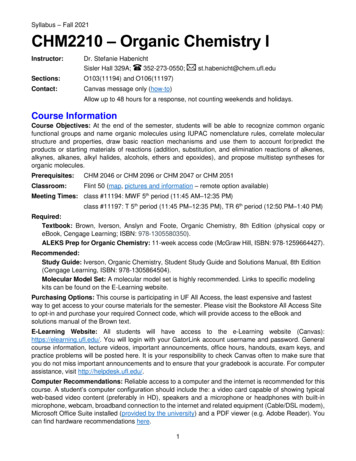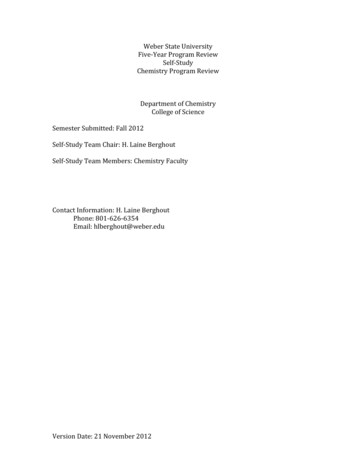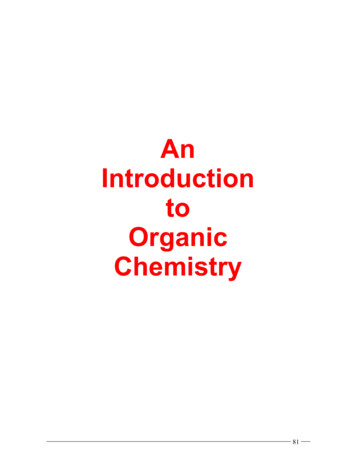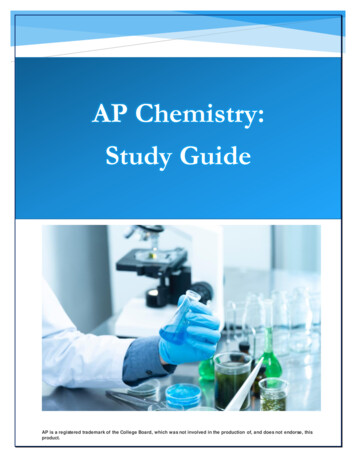
Transcription
AP Chemistry:Study GuideAP is a registered trademark of the College Board, which was not involved in the production of, and does not endorse, thisproduct.
Key Exam DetailsThe AP Chemistry exam is a 3-hour 15-minute, end-of-course test comprised of 60 multiplechoice questions, for which you will have 1 hour and 30 minutes (this counts for 50% of yourscore) and 7 free-response questions, for which you will have 1 hour and 45 minutes (this countsfor 50% of your score).The exam covers the following course content categories: Atomic Structure and Properties: 7–9% of test questions Molecular and Ionic Compound Structure and Properties: 7–9% of test questions Intermolecular Forces and Properties: 18–22% of test questions Chemical Reactions: 7–9% of test questions Kinetics: 7–9% of test questions Thermodynamics: 7–9% of test questions Equilibrium: 7–9% of test questions Acids and Bases: 11–15% of test questions Applications of Thermodynamics: 7–9% of test questionsThis guide will offer an overview of the main tested subjects, along with sample AP multiplechoice questions that look like the questions you will see on test day.Atomic Structure and PropertiesAround 7‒9% of questions on your AP Chemistry exam will cover Atomic Structure andProperties.The physical world is made of matter, which is any substance that has mass and occupies space.Atoms are the fundamental unit of matter, and the smallest unit that retains all the propertiesof an element. Molecules are a group of atoms that are bonded together to form a chemicalcompound. This section will go into detail about the structure and properties of atoms.Moles and Molar MassThe international standard unit of measure for the number of molecules in a substance is a mole.A mole is equal to Avogadro’s number, or 6.022 1023, which is standardized to the number ofatoms that are present in 12 grams of Carbon-12. A mole of a substance is always the samenumber of particles, regardless of what the substance is (e.g., hydrogen atoms, water particles,1
electrons). You can think of this in the same way that a dozen always means 12, regardless ofwhether it refers to eggs or days. The molar mass of substance, also called the molecular weightor molecular mass, is the total mass of one mole of that substance, expressed as grams/mole.Molar mass is used to convert the mass of a substance to the number of molecules present usingthe following conversion:# of moles weight in gramsmolar mass# of moles of substance (# of moles of substance) (Avogadro’s number)This relationship is used to determine the number of molecules present given the massof a pure chemical using the atomic mass on the periodic table. To determine the number ofmolecules present in a compound, calculate the number of moles present using mass in gramsand the molar mass. This number is then multiplied by Avogadro’s number to determine thenumber of molecules.Mass SpectroscopyScientists can measure the abundance of different atoms in a sample using mass spectroscopy.A mass spectrometer separates molecules in a sample based on their charge and weight. To dothis, the sample is first charged by bombarding it with electrons. Magnetic fields then separateions by charge, and the relative abundance of ions in a sample are read by a detector. Ions ofdifferent masses need different strengths of magnetic fields to reach the detector. Results areplotted showing the mass-to-charge ratio on the x-axis (m/z) and the relative abundance of eachatom type on the y-axis. You may be asked on the AP exam to determine the relative abundanceof different isotopes of an element based on mass spec results.Elemental Composition of Pure SubstancesPure substances are made of a single type of substance that has consistent characteristics andcannot be broken down further through physical processes. A pure substance that is made of asingle type of atom is called an element. A pure substance that is made of only one type ofmolecule is called a compound. According to the law of definite proportions, a pure chemicalcompound broken down into elements always contains elements of a fixed ratio, independent ofwhere and how it was created. For example, pure water will always contain the same ratio ofhydrogen and oxygen, regardless of where it is found.2
Composition of MixturesA mixture is made of more than one type of element or compound. The components in a mixturecan have different proportions. For example, you can make a 20% saline solution out of 20%sodium chloride and 80% water, or you can make a 5% saline solution out of 5% sodium chlorideand 95% water; yet both are still saline.When you make a mixture, no chemical reactions take place, so you could stilltheoretically recover the individual components back to their pure forms. In the case of saline,you could evaporate off the water and recover both the sodium chloride and the water. Mixturescan be homogenous, meaning all parts of the mixture are identical to other parts due to evendistribution of compounds, or mixtures can be heterogenous, as in there is a non-uniformdistribution of compounds.Atomic Structure and Electron ConfigurationAtoms are made of smaller subatomic particles including positively charged protons, negativelycharged electrons, and uncharged neutrons. Protons and neutrons together occupy the tightlypacked nucleus of an atom, while electrons orbit outside of the nucleus in electron shells.Together, subatomic particles determine the identity, mass, and charge of an atom.Protons and neutrons have the same approximate mass (1.67 10 -27 kg), while electronscontribute a negligible amount of mass (roughly 1/1,800 the mass of the protons and neutrons).Thus, protons and neutrons are included in estimating mass of an element and electrons are not.The mass number is a whole number equal to the number of protons and neutrons of an element.The mass of a single proton or neutron is 1 atomic mass unit (amu). The number of protons inthe nucleus is called the atomic number. The atomic symbol of an element is represented as:𝐴𝑍𝑋Where X is the element symbol, A is the mass number, and Z is the atomic number. Theatomic number defines which element an atom is. For example, carbon has 6 protons; theaddition of a proton to a carbon atom would make it change to nitrogen. On the other hand, thenumber of neutrons in an individual atom of an element can vary, changing the mass number ofan atom. Atoms with the same number of protons but different number of neutrons are calledisotopes of an element. To determine the number of neutrons in an atom, subtract the atomicnumber from the mass number.Atomic mass is the average mass number of all the atoms of that element. Atomic masson the periodic table can give you an idea of the proportion of isotopes present. For example,lithium (L) has an atomic number of 3 and an atomic mass of 6.941, indicating that many lithiumatoms on Earth have more than the 3 neutrons in their nucleus.3
Atomic charge is determined by the relative number of electrons and protons of an atom.While the number of protons of an atom is stable, the number of electrons varies. Atoms with anon-zero charge are called ions. An atom with an equal number of protons and electrons has aneutral charge. Since electrons are negatively charged, the addition of an electron gives anegative charge to an atom, creating an anion. The loss of an electron gives a positive charge toan atom, which is called a cation.In current atomic models, electrons occupy space outside of the nucleus at discreetdistances and energy levels called shells. The closer the shell is to the nucleus, the lower therelative energy level. Within each shell, there are subshells that have slightly different energylevels. Electron shells are numbered (n 1, 2, 3 and so on), the number of the shell describes thenumber of subshells it holds. Subshells (l) are denoted by the letters and corresponding numbers:0 s, 1 p, 2 d, 3 f, 4 g, 5 h in order of increasing energy and electron holding capacity. The spacewithin a subshell that an electron has the highest probability of being is called an orbital. Eachorbital can hold a maximum of two electrons.You can calculate the number of electrons possible in a subshell or shell easily by usingthe shell number or the subshell letter. The number of orbitals in a subshell (l) is calculated bythe equation 2l 1. In other words, subshell d has 5 possible orbitals (2 2 1 5), and since eachorbital can hold 2 electrons, d has an electron holding capacity of 10. Each shell has n2 orbitalsand can hold 2n2 electrons. For example, the first shell has 1 orbital (s) and can hold 2 electrons(2 12 2) and the second shell has 4 orbitals (1 in s and 3 in p) and can hold 8 electrons (2 22 8).Electrons fill the lowest energy orbitals first. This is called the Aufbau principle. To figureout what shells fill first, follow the diagram showing the orbital diagonal rule. Remember that insome cases, orbitals in shells with a higher number can fill before those of a lower number; forinstance, 4s has a lower energy than 3d, and will fill first. You may be asked on the exam to showthe electronic configuration for an atom. In this notation, each subshell is written out in order of4
increasing energy and the number of electrons in each subshell is written in superscript. Forexample, neutral carbon has 6 electrons. The electronic configuration for this would be 1s 22s22p2,meaning there are 2 electrons in subshell 1s, 2 electrons in subshell 2s, and 2 electrons in subshell2p. To figure out the configuration on your own, you can follow the orbital diagram to map outwhich shells will be filled first.According to Hund’s rule, electrons fill all orbitals of equal energy with one electronbefore pairing electrons. That means that for carbon, the two electrons in the 2p subshell wouldnot occupy the same orbital. To draw this out, you can represent each orbital in a subshell usingthe following diagram:5
Here, each orbital is shown as a line and each electron for iron is shown as an arrow. Youcan fill in each electron for the atom in order of increasing energy. In the case of iron, the highestenergy subshell 3d is not full and only has 6 of 10 possible electrons. Thus, according to Hund’srule, 4 of the 5 orbitals will have one electron and 1 orbital will have two electrons. The directionof an arrow in this diagram indicates the spin of an electron, either spin up or spin down.According to Pauli’s Exclusion Principle, two electrons of the same spin cannot occupy the sameorbital; thus, a single orbital can only have one spin up and one spin down electron.When subshells are not filled, unpaired electrons are present and can interact withmagnetic fields, making the atom paramagnetic. When all subshells are filled, the element doesnot interact with magnetic fields and is called diamagnetic. The outer shell is called the valenceshell, which will be discussed in further detail.The energy that is needed to remove an electron from an atom is called ionization energy.Coulomb’s law is used to calculate ionization energy, or the energy needed to move an electronfrom one energy shell to another. According to Coulomb’s law, the force of attraction or repulsion(F) between two charges is proportional to the product of charges (Q) divided by the square ofthe distance between them (r).𝐹 𝑘𝑄1 𝑄2𝑟2From this equation, you’ll find that the attractive force between protons and electrons ishighly dependent on their distance from the nucleus. In other words, it will take more energy toremove electrons that are closer to the nucleus than those that are farther away. Be prepared touse this calculation to estimate relative ionization energies on the AP exam.Photoelectron SpectroscopyPhotoelectron spectroscopy (PES) is used to determine how many electrons an atom has andwhere they reside. This technique relies on ionization energy. In photoelectron microscopy, highenergy radiation is focused onto a substance and the kinetic energy of electrons and relativeabundance of electrons at each energy is detected. This information can be used to calculate anelectron’s binding energy, the energy needed to remove an electron from a subshell of an atom.To remove an electron from an atom, the energy applied must be greater than the bindingenergy of the electron. The closer an electron is to the nucleus of an atom, the stronger theattraction to the nucleus; thus, electrons closer to the nucleus have greater b inding energies. Ina PES spectra, high energy peaks are made by electrons emitted from orbitals closer to thenucleus of the atom, and low energy peaks are made from electrons in or near the valance shell.The heights of the peaks can be used to calculate relative abundance, which is then used to6
determine the identity of an atom. In the free response exam section, you may be asked toidentify elements and electron configurations based on PES spectra.Periodic TrendsBesides organizing elements based on atomic numbers, the periodic table provides anorganized structure that helps define categories of elements. The rows of the periodic table arecalled periods, which define the highest energy level an electron of that element occupies at rest.The columns of the periodic table are called families that share valence electron configurations.Physical properties of elements are shared in periods and families, with families generallyhaving stronger effects than periods. For example, when you move right to left and top to bottomon the periodic table elements become more metallic. These physical properties are due to theelectron configurations. The atomic radius gets larger as you move down a family or from left toright across a period. This is because there are more electron shells as you move down the periodand the diameter of these shells contracts when the valence shell becomes occupied.7
On the other hand, the ionization energy increases as you move from left to right andfrom bottom to top. This is due to the higher stability of electron shells closer to the nucleus andthe higher magnetic pull of nuclei with more positively charged protons on negatively chargedelectrons. In the free response section, you may be asked to explain the basis for periodic trends.You should be familiar with the basic families on the periodic table and their features:Alkali metals (1): These are shiny, soft, and very reactive. All have their outer electron in an sorbital that reacts easily. They are never found uncombined in nature, as they are highly reactive.They react violently with water, causing an explosion. These often lose one electron to take on a 1 charge.Alkaline earth metals (2): These are shiny, silver-white metals that are semi-reactive. Theoutermost s orbital is full, so they can form cations with a charge of 2. These are known to reactwith halogens and form ionic halides, and all but Beryllium react with water to form a hydroxideand hydrogen gas. These often lose two electrons to take on a 2 charge.Transition metals: These have a partially filled d sub-shell, so they can form cations with anincomplete valence shell. These are less reactive, so are often found uncombined in nature. Thesecan conduct electricity, form magnets, and make compounds with color.Chalcogens (16): These have 6 electrons in their outer shell, so often form anions with a -2charge. These form compounds through covalent bonding.Halogens (17): These have 7 electrons in their valence shell, so they tend to form anions in waterwith a -1 charge. These tend to form compounds with covalent bonds or are found as highlyreactive diatomic molecules. When combined with hydrogen, these form strong acids.Noble gasses (18): These are virtually unreactive, colorless, odorless, gases. These have a fulloctet of valence electrons, so are found uncompounded in nature and are difficult to get to formreactions.Valence Electrons and Ionic CompoundsWhen the valence shell is not full, electrons in this shell can interact with other atoms by formingionic bonds. An ionic bond forms when an atom donates a valence electron to another atom,typically a metal and a non-metal. The atom that loses an electron becomes a positively chargedcation, and the atom that gains an electron becomes a negatively charged anion.The opposite charges of the atoms attract them together, causing an ionic bond to form.Ionic bonds help to increase the stability of the atoms involved by having the optimal number ofelectrons in the valence shell. The first five elements in the periodic table are most stable when8
they have 2 electrons in their 1s orbital; this is called the duet rule. Thus, in ionic compounds,these elements aim to gain or lose enough electrons to have two total. For most elements withmore than 5 protons, the optimal configuration is to have eight electrons in the valence shell;this is called the octet rule.In ionic compounds these atoms will gain or lose electrons, to have a total of eight in theirvalence shell. As mentioned previously, columns on the periodic table are organized by thenumber of valence shell electrons. Thus, elements in the same column tend to have similarcharges as ionic compounds and will tend to form analogous compounds (e.g., NaCl and KCl).Outside Reading For more information on atomic structure and mass:o try/chapter/thestructure-of-the-atom/o s For more information on mass spectroscopy:o works.html For more information on photoelectron microscopy:o ay-sal/a/photoelectron-spectroscopy For more detailed information periodic trends:o try/chapter/periodictrends/ For further reading on ionic compounds:o r/ionic-bonds/9
Atomic Structure and Properties QuestionsWater has a molecular mass of 18 and has one atom of oxygen to two atoms of hydrogen. Whichof the following choices is the procedure to calculate the mass ratio of hydrogen to oxygen inwater?A.2 0.11118B.2 0.12516C.16 0.88818D.16 8.0002Explanation:The correct answer is B. Water (molecular mass 18) has one atom of oxygen (atomic mass 16) totwo atoms of hydrogen (atomic mass 1). The mass ratio of hydrogen to oxygen in water is2 0.125.16A 100-g sample of CaCO3 (FW 100 g/mol) was heated at 500 C for 12 hours. Afterwards, theremaining solid was found to have a weight of only 56 g. Which balanced chemical equation bestdescribes the reaction that took place?A. CaCO3(s) heat CaCO(s) O2(g)B. 2CaCO3(s) heat 2CaC (s) 3O2(g)C. CaCO3(s) heat CaO(s) CO2(g)D. CaCO3(s) heat 2CaO2(s) CO(g)Explanation:The correct answer is C. The molecular weight of CaCO3 is 100 g/mol, meaning one mole ofmaterial was heated. The remaining solid must also represent one mole of material and have amolecular weight of 56 g. CaCO has as molecular weight of 68 g/mol.10
Which of the following electron configurations is isoelectronic to Cl –?A. 1s22s22p63s23p3B. 1s22s22p63s23p4C. 1s22s22p63s23p5D. 1s22s22p63s23p6Explanation:The correct answer is C. Isoelectronic means having the same electrons. Chlorine has 17electrons and the chloride ion has one more (18). This answer has 18 electrons.11
Molecular and Ionic Compound Structureand PropertiesAround 7‒9% of the questions on your AP exam will cover Molecular and Ionic CompoundStructure and Properties.Types of Chemical BondsChemical bonds are the attractive forces between atoms that hold them together, includingsharing electrons and other electrostatic forces. These forces can be intramolecular, as in theyoccur within a molecule, or intermolecular, as in occurring between molecules. Intramolecularforces are stronger than intermolecular forces. The main types of intramolecular binding forcesare summarized in the following table.BondDescriptionCovalentThe sharing of electrons between a pair of atoms, also called amolecular bond. Covalent bonds can result in atoms having completevalence shells, stabilizing the atoms. These are usually gasses, liquids,or soft solids and include most biological molecules. The first covalentbond is called a sigma bond ( ) and additional bonds are called pibonds ( ). The sigma bond is the most stable.Ionic bonds describe the electrostatic attraction between cations andanions or with charged polyatomic ions. Ionic bonds involve thetransfer of electrons from a metal to a non-metal, resulting in fullvalence shells for both atoms. Ionic bonds tend to be easily separatedby external forces, like the addition of polar solvents, causingsubstances to break apart into anions and cations. Solid, ionicallybonded structures form ordered and strong lattices that are nonconductive and have high melting and boiling points. This groupincludes salts.Metallic bonds are the sharing of free electrons in a metallicstructure, composed of charged cations. In metallic bonds, valenceelectrons are only loosely bound to the nucleus and form a sort ofcloud around metallic cations, allowing them to be shared. Thisresults in a highly stable configuration of positively charged cations ina sea of negatively charged electrons. Metallic bonds account forcertain features of metals like malleability, conductivity, and luminumfoil
One way to predict whether a bond is ionic or covalent is to look at the electronegativityof the atoms involved. Electronegativity describes how much an atom attracts bonding electrons.The scale runs from 4 (fluorine) at the high end to 0.7 (cesium and francium) at the low end. Onthe periodic table, electronegativity increases from left to right and bottom to top (excludingnoble gasses).Another way to think of electronegativity is as a quantitative way to consider how factorslike the atomic structure, valence shells, and Coulomb’s law affect attraction between ions. Todetermine bond type, remember that when the difference between electronegativity is high(greater than 1.7), ionic bonds form. When the difference is low (1.7 and lower), covalent bondsform.Covalent bonds formed between atoms with similar electronegativities ( 0.5) are nonpolar covalent bonds. This means that electrons are shared equally across the atoms. A polarcovalent bond forms when there is a larger difference in electronegativity across atoms. Theatom with the greater charge pulls electrons closer to it, forming a dipole. In a dipole, electronsspend more time at one end of the molecule, giving that side a slightly more negative charge ( ) and the other end a slightly positive charge ( ). This can result in molecules that are charged,or polar, and can interact with other molecules through these charges.The size of a dipole is measured by the dipole moment, . When the difference betweenthe dipole is very high, the molecule at the end of the bond essentially transfers its electronsto the more electronegative atom, forming an ionic bond. The direction of a dipole is ind icatedin a bond as an arrow from the less electronegative atom to the more electronegative atom.Intramolecular Force and Potential EnergyDuring covalent bond formation, unstable atoms with incomplete valence shells share electronsto increase their stability. Attractive forces between the nuclei and electron clouds of unstableatoms attract each other to form a bond. This is counteracted by repulsive forces between eachatom’s nuclei and between each atom’s electron clouds. This balance between repulsive andattractive intramolecular forces can be shown in a potential energy diagram.13
In this diagram, when the two molecules are far apart there is no potential energy, orstored energy. The closer the molecules get to each other, the lower the potential energy due toattractive forces between the molecules (remember Coulomb’s law). The distance where thispotential energy is lowest is the average length of the covalent bond that forms between them.In other words, covalent bond lengths are optimal when the potential energy of the bond islowest. You’ll notice in the diagram that when the molecules get even closer together, thepotential energy rapidly shoots back up. This is due to repulsive intramolecular forces betweenthe atoms. In the case of double and triple bonds, the bond length becomes shorter and thestrength of the bond becomes higher; thus, you can expect to see shorter lengths between nucleiand higher bond energies.Structure of Ionic SolidsIonic solids form in a manner that reduces the repulsive forces between similarly charged ionsand increases the attractive force between oppositely charged ions. This forms a chemical latticewith an orderly arrangement. The lattice energy (E) is the energy needed to separate 1 mol of anionic solid into its gas phase. This is proportional to the product of the electrical charges of theions (Q) divided by the sum of the radii of the atoms (r):𝐸 𝑄1 𝑄2𝑟14
Note that when the ions are oppositely charged, the lattice energy is negative. Thisindicates energy will be released when the lattice forms due to attraction between the molecules.The more negative the lattice energy is, the stronger the ionic bonds will be. These strong bondsholding ionic solids together explains some of the features of ionic solids such as crystalstructures and brittle properties.Structure of Metals and AlloysMetallic solids are formed by an array of metallic cations surrounded by a sea of freely movingshared electrons. The loose shared electron sea helps to understand some of the features of puremetals, such as conductance, malleability, and ductility. When metals are mixed with othermetals or non-metals, alloys are formed. When two metals of similar size are mixed, asubstitutional alloy is formed. The percentages of metals in a substitutional alloy can be variedto alter the properties of the alloy, such as increasing strength and conductivity while decreasingcorrosion. When a pure metal is mixed with a much smaller metal or non-metal, an interstitialalloy is formed. Interstitial alloys are stronger, harder, and less ductile than their pure hostmetals.Lewis DiagramsLewis dot diagrams are a quick way to represent the valence electrons of an atom, where eachdot around a molecule represents a valence electron. A covalent bond is represented by dotsbetween atoms, or by dashes corresponding to the number of covalent bonds. According to theoctet rule, most atoms are considered stable when this valence shell is occupied by eight atoms;thus, the optimal configuration is to have 2 electrons on each of the 4 sides or 4 total bonds.Hydrogen atoms only need two electrons in their valence shells.15
When drawing a dot diagram for a compound, first arrange the ions so they form asymmetrical structure. Remember that hydrogen is always on the outside of the structure, nevercentral. Then calculate the total number of valence electrons the molecule has vs. the number ofmolecules needed (generally 8 for every molecule except hydrogen). The difference between thenumber of electrons the molecule has and the number needed tells you how many electrons areshared. Then divide shared electrons by two to find out how many are between elements in thismolecule. You then draw the bonds and complete the structure by adding the remainingelectrons so that each atom has the correct number of valence electrons.Lewis dot diagrams do not handle unpaired electrons well or show the differencebetween the strength of bonds; these cases are better described by models that take intoaccount 3-D structure.Resonance and Formal ChargeResonance structures are not adequately represented by dot diagrams. These are instancewhere two forms of a molecule are possible with the same connectivity but with differences inthe distribution of electrons. For instance, ozone can exist as O O O or O O O. In reality, thesewould exist as partial bonds, but for the purpose of demonstration would be written as follows:O O O O O O.You may come across instances where there are multiple possible Lewis structures. Todetermine which is the most appropriate, you can calculate the formal charge of the atoms inthe chemical compound:Formal charge (# valence electrons) (# nonbinding electrons bonding electrons)2The most favorable Lewis structures will have small formal charges on each element:more electronegative elements will have lower formal charges, like charges will be far apart, andunlike charges will be near. The total formal charge for the molecule is the sum of the formalcharges of the atoms.Note that you may be asked on the exam to compare the relative contribution of differentresonance structures possible for a molecule. In that case, the resonant structures that are morecommon are those that satisfy the octet (or duet) rule for all atoms that have a formal charge oneach atom closest to zero, and where more electronegative elements have lower formal charges.16
VSEPR and Bond HybridizationValence shell repulsion theory, or VSEPR, asserts that electron pairs repel each other andunbonded electrons are even more repulsive to bonded pairs. This causes molecules to take ondistinct shapes depending on the number of bonds and hybridized orbitals. For example, amolecule with two sigma bonds will take on a linear shape so that both bonds will be as far apartas possible. A molecule with four bonds will take on a tetrahedral shape to optimize distance.You will need to estimate molecular shape for the exam using VSEPR. To determine the shapeof a chemical compound using VSEPR:1. Draw out the Lewis dot diagram.2. Count the number of electron-dense regions. These include each element in thecompound as well as each pair of electrons.3. Mentally arrange these electron dense regions to allow equal space
This guide will offer an overview of the main tested subjects, along with sample AP multiple-choice questions that look like the questions you will see on test day. Atomic Structure and Properties Around





